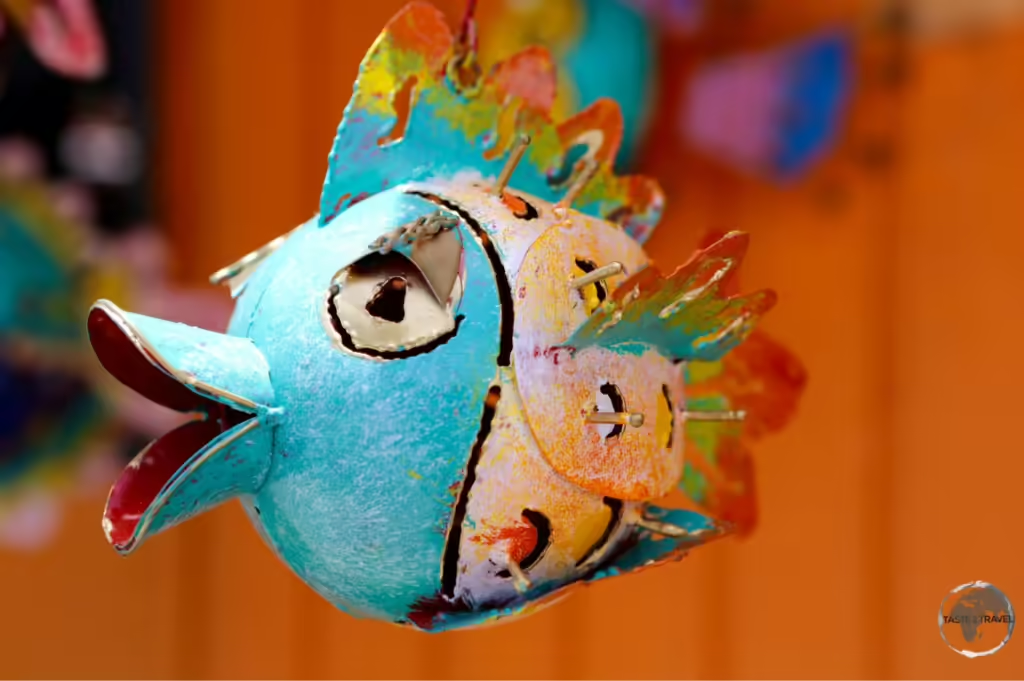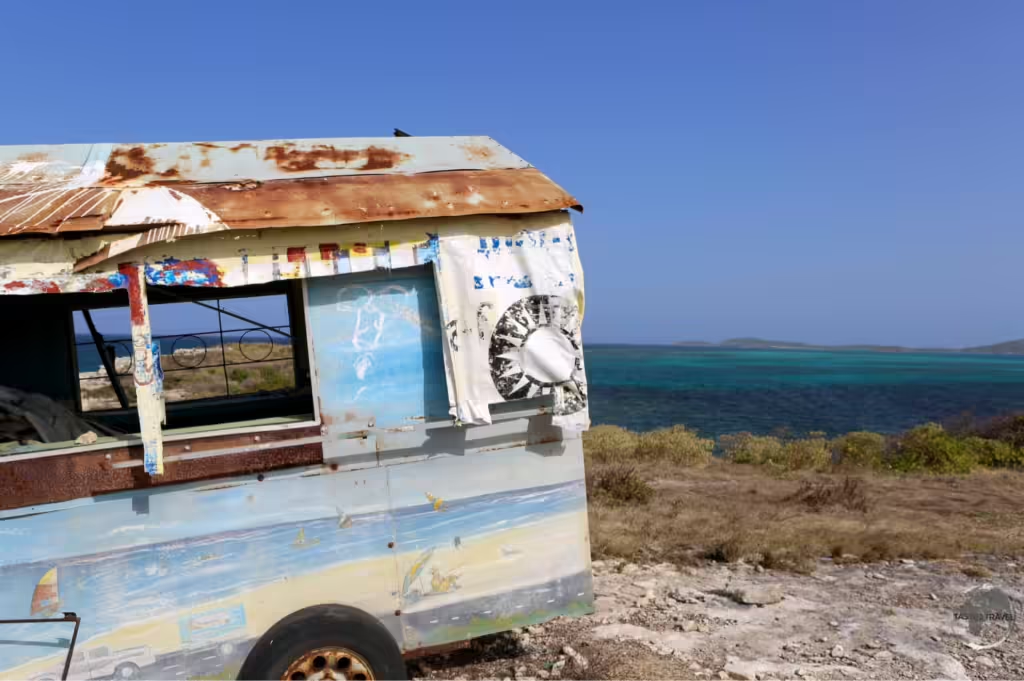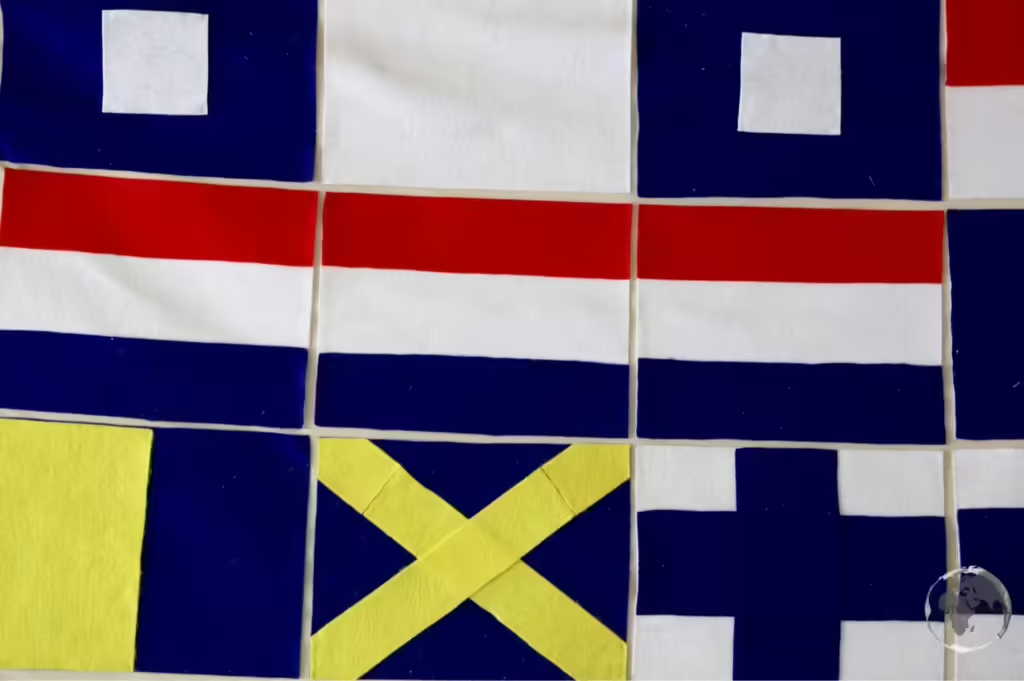Antigua Travel Guide
Welcome to the taste2travel Antigua Travel Guide!
Date Visited: April 2015
Introduction
Antigua is one of the two islands, which comprise the sovereign nation of Antigua & Barbuda. The islands lie 30-km apart. Barbuda is not covered in this post as it was not visited.

Artist studio in English harbour, Antigua.
Antigua is part of the Leeward Islands, which are a part of the Lesser Antilles lying north of Guadeloupe, north-east of Montserrat and east of St. Kitts & Nevis.
Location
Antigua and Barbuda
The islands of Antigua and Barbuda are located in the Lesser Antilles, in the eastern Caribbean Sea, at the southern end of the Leeward Islands chain. The two islands lie 63 km (39 mi) apart and are connected by a daily ferry service.
Antigua is generally a low-lying island, essentially a large chunk of exposed limestone sea bed. In the south-west is a volcanic section, here you will find a few peaks and intense agriculture in the rich volcanic soil. The islands highest peak is located here – it was recently renamed Obama Peak (402-m).
All this limestone ensures lots of white sandy beaches and turquoise waters. The islands are rimmed by coral reefs. The flat terrain ensures little rainfall and there are few rivers or streams on the island. Most of the terrain is dry and arid, cacti are a common feature. Both islands lack adequate amounts of fresh groundwater.
History
For millennia the islands were inhabited by a succession of native Indian tribes, first the Ciboney (or Siboney), who migrated from present day Cuba, then the Arawak, who migrated from Venezuela then the more aggressive Caribs.

Antigua and Barbuda Flag
The Arawak introduced agriculture to the island, including the first pineapples, which would eventually evolve into today’s famous Antigua black pineapple (see the ‘Eating Out‘ section below). Antigua was originally called Wa’ladli by the Arawak Indians and is still called this today by the locals.
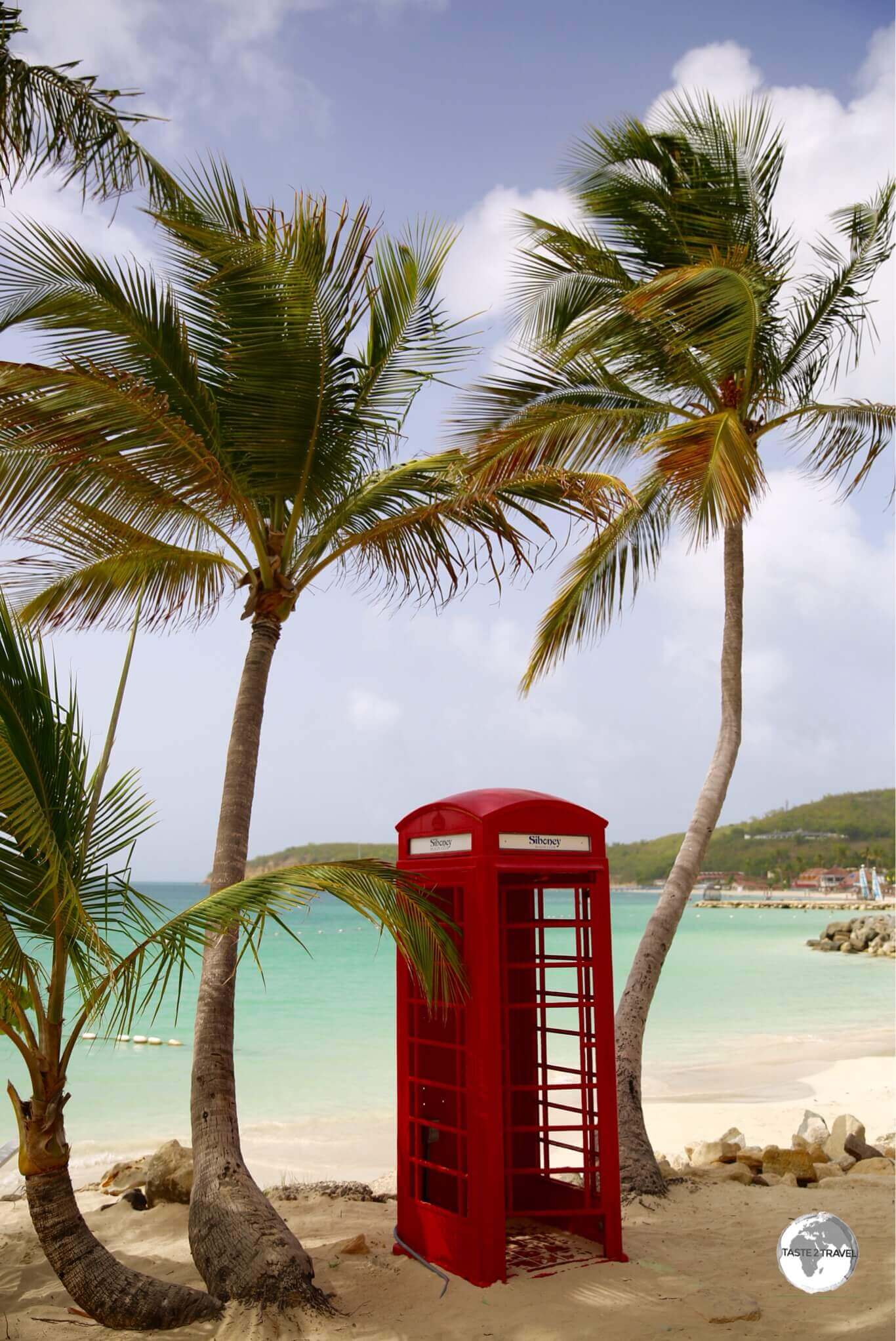
Dickenson Bay is a popular beach and home to the Sandals Grande Antigua resort.
Everything changed in 1493 when Christopher Columbus discovered the island. He named it Antigua in honour of La Virgen de la Antigua housed in the Seville Cathedral in Spain. When Columbus arrived he found a lack of fresh water but no lack of aggressive Caribs, hence the island was never settled by the Spaniards.
The islands were neglected by the early European colonisers but in 1632 the British established a settlement at St. John’s. In 1685 Barbuda was leased to brothers John and Christopher Codrington who ran the island as a private estate and used it as a nursery for slaves who worked on their sugar plantations on Antigua. The capital of Barbuda today is ‘Codrington’.

Turks Head Cactus on Antigua.
Like almost everywhere else in the region, the British established sugar plantations on the island and imported slaves from Africa as a labour source. Today the population of 89,000 is mostly (91%) Afro-Caribbean, descendants of the former slaves.
In 1981, the islands were granted independence as the modern state of Antigua and Barbuda.

The national flower of Antigua & Barbuda, the Dagger Log, is an Agave plant.
Economically, tourism is now the main game on the island. Off-shore banking is another important industry.
Sightseeing
St. John’s

Colourful souvenir at an artist’s studio in English harbour.
St. John’s is the capital and largest city (population: 22,000) of Antigua & Barbuda. The city has been the administrative centre of Antigua and Barbuda since the islands were first colonised in 1632. Today it is the seat of government.
Antigua is a centre for offshore banking, many international banks have offices in the city. St. John’s is a little more developed and cosmopolitan compared to other cities in the region.
There is a large modern cruise ship terminal in the city centre, which can cater for up to four ships. Around 50% of visitors to the island are day-tripping cruise ship passengers.
Attached to the terminal are two modern shopping malls, Heritage Quay and Redcliffe Quay. These offer the usual assortment of tourist shops.
The city centre is small and compact and all sites can easily be covered in a day.
Sites include:
- St. Johns Cathedral – The main landmark in the city, the present cathedral was built on a fossilised reef in 1845. It is the third cathedral to occupy the site, the previous two being destroyed by earthquakes. The original cathedral (a wooden structure) was consecrated in 1681.
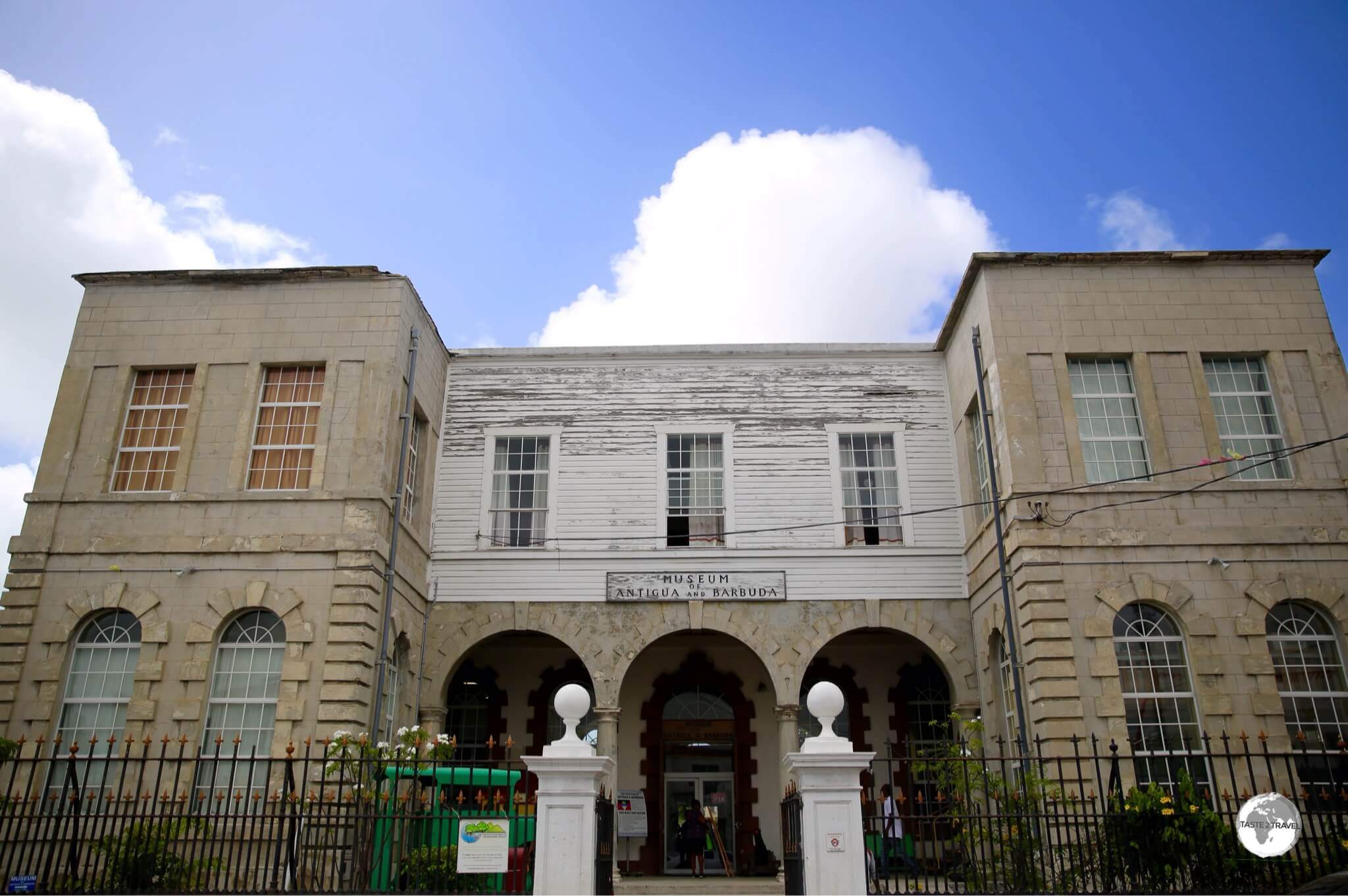
The Museum of Antigua & Barbuda in St. Johns.
- Museum of Antigua & Barbuda – The museum provides an overview of the history and culture of Antigua & Barbuda. It covers an array of subjects and offers an eclectic mix of displays, from a model Arawak dwelling to Viv Richard’s (the islands’ greatest cricket player) cricket bat.
- Market – located on the southwestern edge of the city, this bustling market is the place to purchase your black pineapple (see the ‘Eating Out’ section below) and all other local produce

Sunset from Fort James.
- Fort James – on the outskirts of the city, the fort is located at the entrance to the harbour of St. John’s. The British, fearing a French invasion, constructed the fort in order to protect the harbour in the 18th century. This is a great place to watch the sunset over the Caribbean sea.
A reasonable place for either breakfast, lunch or dinner in downtown St. John’s is the Hemingway Caribbean Cafe. This cafe is a local institution and is housed upstairs in an historic wooden West Indian styled building on St. Mary’s street. Service and food can be hit or miss.
Around the Island
Nelsons Dockyard

Remnants of the former Nelson’s dockyard at English harbour.
Nelson’s Dockyard is located in English Harbour on the south side of the island. The dockyard is named after Admiral Horatio Nelson, who lived here from 1784 to 1787.
The British established a naval base here in the early 18th century as it was ideal to monitor French activities on neighbouring Guadeloupe. The harbour also proved to be a safe haven in the event of hurricanes. Most of the buildings on the site were built using slave labour from neighbouring plantations.
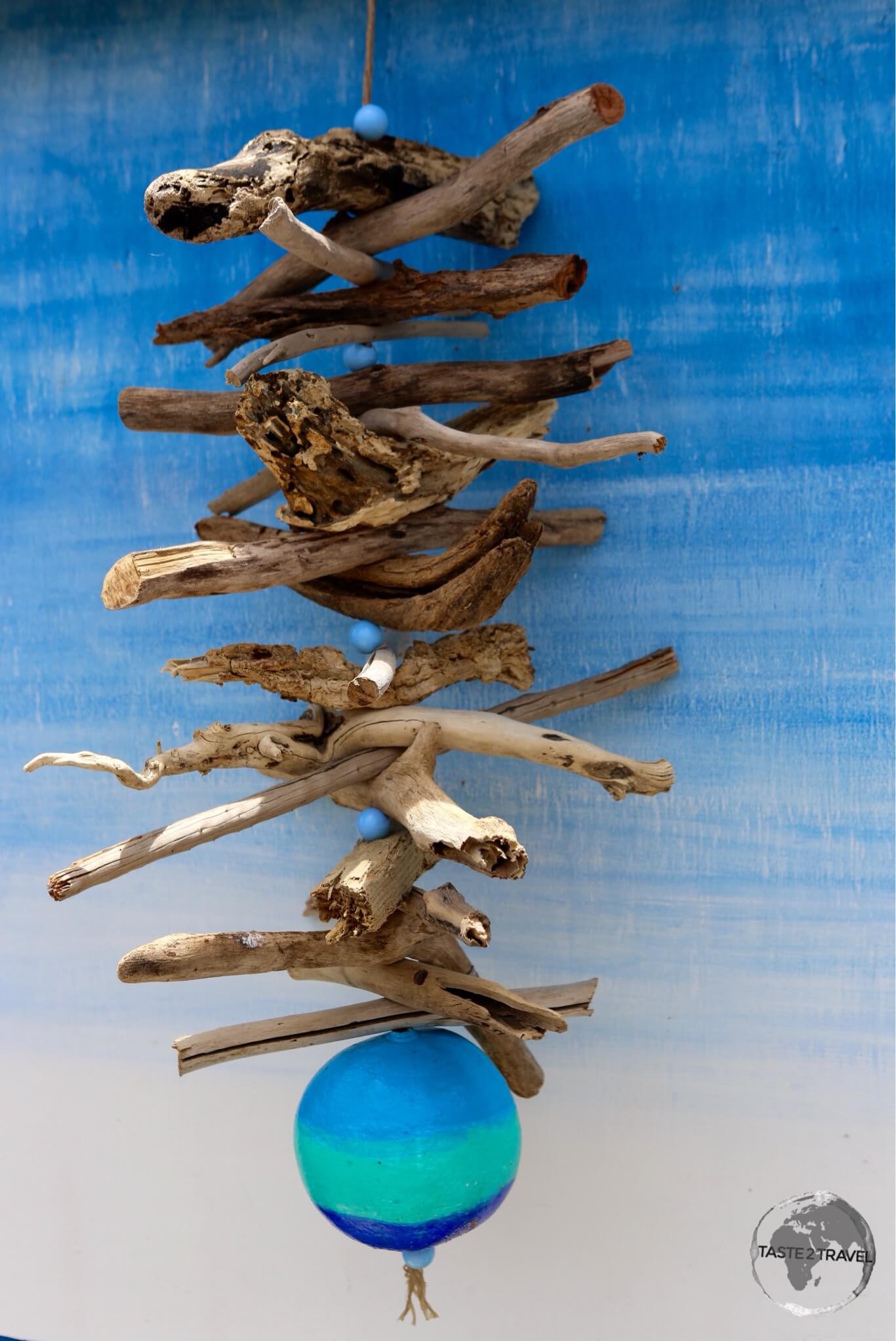
Souvenir shopping in English Harbour, Antigua.
In 1889 the Royal Navy abandoned the Dockyard and it fell into decay. It was restored in the 1950’s.
Today it is one of the most popular attractions on the island, offering a marina, museums, shops, cafes, restaurants etc. It is also home to Antigua Sailing week (see below).

English naval flags at Nelson’s Dockyard.
One of the main sites at the Dockyard is the museum. It was originally built in 1855 and served as an officers’ quarters in the Royal Navy Dockyard. It was restored in the 1970’s and opened as a museum in 1997.
Today the museum presents the history of Nelson’s Dockyard and includes information on the interesting, and scandalous, personal life of the Admiral.

Museum at Nelson’s Dockyard.
Sailing Week

Antigua has established itself as a premier sailing destination.
The last week of April brings sailors from around the world for Sailing Week. It’s one of the top five regattas in the world and the centre of the action is Nelson’s Dockyard.
During the regatta there is lots of action on the water and lots of apres action around Nelson’s Dockyard, including nightly concerts on a main stage, live bands in various other venues and nightly food markets showcasing Antiguan cuisine.
I was fortunate to be staying on the island during sailing week in 2015. It’s a great party.
Shirley Heights

View of the south coast towards English harbour from Shirley Heights
Shirley Heights is an old British naval lookout post. It is located on the south coast of the island and at an elevation of 150-m, offering panoramic views of English harbour, the coast and beyond. From here the British could keep an eye on the French on neighbouring Guadeloupe.
It is ‘the’ place to watch the sunset and on Sunday afternoons (from 4pm) you can enjoy a BBQ with a steel band. There are many old military buildings, which have been restored and can be visited.
The whole complex is located inside a national park so you need to pay to enter. Entrance to the park and fort is on an access road beyond English harbour.
Devil’s Bridge

Devil’s Bridge, a natural stone bridge on Antigua.
Situated at the end of a rocky road on a barren, wind-swept peninsula in the far north-west of the island is a natural limestone bridge known as Devil’s bridge. The bridge gets it’s name from the fact that it was a favourite place for slaves to commit suicide, and no jumper ever survived the rough surf so locals believed the devil lived here. You can walk across on a calm day but you should never attempt a crossing on a windy, rough day (most days). You can reach the bridge after passing the Verandah Resort & Spa beyond the town of Wilikies.
Located a short drive north of St. Johns, beautiful Dickenson Bay offers more powdery white-sand beaches, turquoise water and lots of accommodation options, including the mega-size Sandals Grande Antigua resort.

Sunset at Dickenson Bay.
Betty’s Hope

Old windmill at Betty’s Hope Plantation
Betty’s Hope is a former sugar plantation and is synonymous with the history of Antigua.
The plantation was first established in the early 1650s by a British Governor. After his death his wife inherited the plantation, however she abandoned it during the French occupation (1666). After the British recaptured the island in 1674 they awarded the estate to the Codrington family. This was the first sugar plantation for the family, who eventually owned 150 plantations on the island and established farming on neighbouring Barbuda. Most of the work was performed by slave labour imported from Africa.
Today one of the two windmills has been fully restored and you can visit an interpretation centre, which provides an overview of the sugar industry on the island.
Betty’s Hope is located along a dusty track just off Pares Village Main road beyond the town of Pares in the east of the island.
Antigua Beaches

A view of Half Moon Bay, Antigua.
As the tourist brochures proudly boast – “There are 365 beaches on Antigua – one for each day of the year”.
No matter which coast you are on, you will be be spoiled for choice. Although partly volcanic in origin, most of Antigua is raised limestone seabed which means lots of powdery white sand and turquoise waters. There are no shortage of beautiful beaches on this little island.
Half Moon Bay

Raking Sargassum seaweed off Half Moon Bay.
Located in the far east of the island is this remote beach. It is well worth the drive. You will be rewarded with crystal clear water, gentle waves and good snorkeling. Depending on the tide there can be a lot of seaweed either in the water or on the beach.
There is a small beach side kiosk serving snacks but not much else. It’s all wonderfully quiet and under-developed.
Long Bay
Located in St. Phillip parish in the far east, this beautiful beach offers lots of white powdery sand, calm waters and a reef with very good snorkeling just offshore (eastern end). There is a restaurant here, which serves lunch.
Accommodation
There is a variety of accommodation to suit all budgets around the coast of Antigua, from large scale all-inclusive resorts to privately owned B&B’s. The interior of the island is flat, dry and barren and of little interest to tourists.
If you want easy access to cafes, restaurants, bars etc, the best location is around English Harbour in the south.
I stayed at Villa Touloulou, which offers nice apartments on a hillside overlooking English Harbour – highly recommended. I booked this on booking.com
The capital, St. Johns, is not too attractive but is a good location for those without their own transport.
Eating Out
The national dish of Antigua is fungie (pronounced “foon-jee”), it’s a dish that’s similar to Italian Polenta, but made from cornmeal.
As with the other Anglo-Caribbean Islands, Chinese and Indian cuisine is also available. Jamaican jerk is also popular on the island and a great place to try this is at one of the nightly food stands at English Harbour.
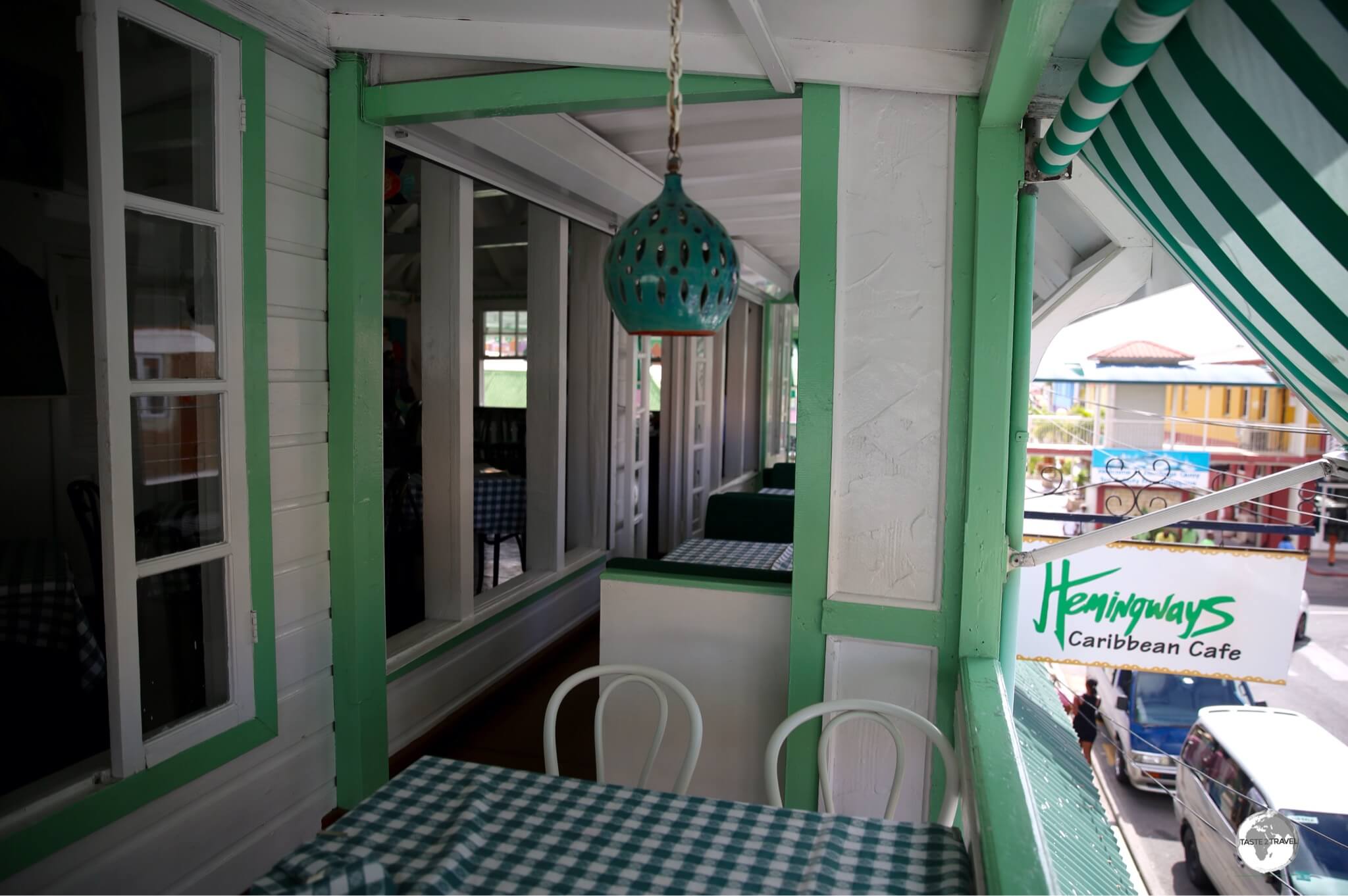
The charming Hemingway’s Caribbean Cafe in St. Johns.
A wonderful dining option in downtown St. Johns is Hemingway’s Caribbean Cafe which is located upstairs in a charming colonial-era wooden building on St. Mays street (opposite Heritage quay). I like to dine outside on the breezy verandah which overlooks the hustle and bustle below. The menu features Caribbean and International dishes and is open for breakfast, lunch and dinner. Especially recommended are the freshly squeezed local juices – my favourite is Sour sop.
One of my favourite restaurants for either breakfast, lunch or dinner is Rum Baba. This Mediterranean bistro is located opposite the entrance to Falmouth Harbour Marina. The food here is exceptional but everyone knows it so you need to book early to reserve one of the few precious tables.
Antigua Black Pineapples
Said to be the sweetest pineapples in the world. It’s believed the native Arawak Indians brought the first pineapples to Antigua from South America more than 1,000 years ago. Over the years these pineapples adopted a distinctive flavour from Antigua’s unique environment, a combination of the soil, not too much rainfall and lots of sunshine.
You can find these ‘sweeties’ at road-side stands around Carlisle bay or in the central market in St. Johns.
Visa Requirements
Some nationalities require visas for Antigua & Barbuda – check your visa requirements prior to arrival.
Getting There
By Air
All flights to Antigua & Barbuda arrive at V. C. Bird International Airport, which is located 8-km northeast of St. Johns. The airport was originally built as a US Air Force base. A brand new, modern terminal (with 4 air bridges) opened in August 2015.
This airport serves as a base for LIAT – an airline with a terrible service record but unfortunately a monopoly on many regional routes.
The following airlines provide international connections:
- Air Canada – services to Toronto (Pearson)
- Alitalia Charter: – services to Milan–Malpensa
- American Airlines – services to Miami, New York (JFK)
- Blue Panorama Charter: – services to Milan–Malpensa (resumes 13 July 2016)
- British Airways – services to London (Gatwick), Turks & Caicos (Providenciales), Saint Kitts, Tobago
- Caribbean Airlines – services to Kingston, Port of Spain
- JetBlue Airways – services to New York (JFK)
- LIAT – services to Anguilla, Barbados, Dominica (Douglas/Charles), Pointe-à-Pitre, Port of Spain, San Juan, St. Croix, Santo Domingo, St. Kitts, St. Lucia (Vigie), St. Maarten, St. Thomas, St. Vincent, Tortola
- PAWA Dominicana – services to Santo Domingo, St. Maarten
- United Airlines – services to Newark
- Virgin Atlantic – services to London (Gatwick)
- WestJet – services to Toronto (Pearson)
By Sea
There is one international ferry service currently operating between Antigua and neighbouring Montserrat. For schedules and fares you should check the Jenny Tours website.
The only other way to arrive by sea is by private yacht or cruise ship. The marina at Nelson’s Dockyard is a haven for yachts, with regular sailing events being scheduled throughout the year.
Cruise ships arrive at the port in St. Johns.
Getting Around

Not all transport options on Antigua are reliable.
Ferry
There is a daily ferry service, which connects Antigua (St. John’s) with Barbuda. The crossing time is 90 minutes. Check the Barbuda Express website for schedules and fares.
Bus
The public transportation system in Antigua is made up of privately owned buses (mostly mini buses). Most of these start from St. John’s from either the East Bus Station or the West Bus Station. You can view the bus routes here.
Taxi
Taxis are also available.
Rental Car

The license plate of my Antigua rental car.
The best option for exploring the island is to hire a car upon arrival at the airport. As with other Anglo-Caribbean countries, the government of Antigua raises revenue by requiring anyone hiring a car to hold a temporary driving permit. This can be purchased at the car rental agency.
As with other Anglo-Caribbean islands, road signage is almost non-existent. Best to always stop and ask the locals for directions – a great way to get to know everyone on the island.
Safe Travels!
Darren
Follow me on Instagram:
[instagram-feed feed=1]
Further Reading
Other travel reports from the Caribbean region include:
Antigua Travel Guide Antigua Travel Guide Antigua Travel Guide Antigua Travel Guide Antigua Travel Guide Antigua Travel Guide Antigua Travel Guide Antigua Travel Guide Antigua Travel Guide


